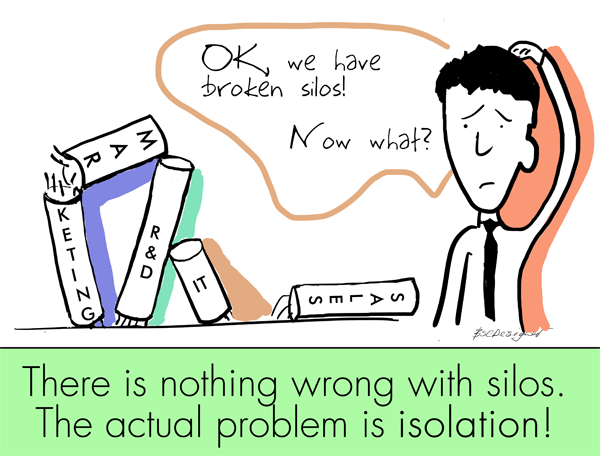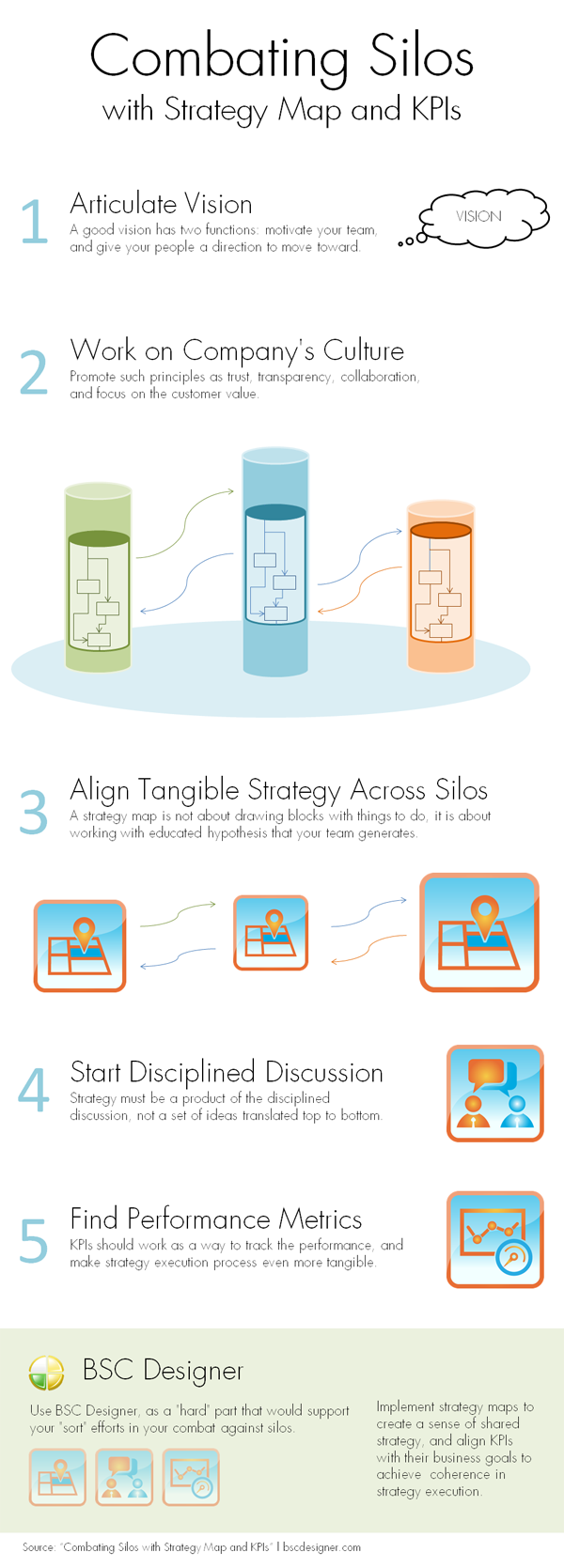Silo thinking is often named as one of the problems of effective strategy execution. Let’s analyze the case to find out what the real problem is and how to fix it.
Organizations are divided into silos – Sales, Marketing, Customer Service, IT, R&D… This approach is natural when you need to get a sense of a big and complex system; this is also a great way to divide responsibilities and scale organization. The problem is that neither clients’ requests, nor business challenges in general fit into a single silo, on the contrary, they tend to go across organizations. The most important question: will they go through-out the silos effortlessly or not.

Looks like most organizations cannot exist without silos…
How do you eat an elephant? One bite at a time. How does an organization deal with complex challenges? They create separate business units to address smaller parts of the challenge. Looks like most organizations cannot exist without silos…
Having said that I’m sure someone will not agree in the comments:
- “Wait a minute, but what about Zappos and other companies that adopted self-organization?”
First of all, Zappos has “circles,”1 so there are still some typical roles, but their number was reduced. As it is explained in the article Misperceptions of self-management by Frederic Laloux2: “The tasks of management … haven’t disappeared. They are simply no longer concentrated in dedicated management roles.”
Second, in the self-organization there are envisaged some safety mechanisms like creating peer pressure, antibody framework, and a process for conflict resolution.
Third, their holacratic3 approach is not suitable for any random business. For example, in his memo Tony Hsieh clearly states that “managers were absolutely necessary and valuable to the growth of Zappos.”
Finally, the “solution” part for the silos problem is very similar to what is implemented in self-organizations. Performance metrics are still there and there is even a higher focus on discussing challenges with your colleagues.
Isolation is your problem, not silos
But let’s get back to the classical “silo” metaphor. I believe there is one thing that we need to be clear about:
There is nothing wrong with silos. The actual problem is isolation!
The idea is not to smash silos in the company, but to ensure that there are effective communication channels between them, and that they have a shared strategy in mind.
This should be done:
- On the cultural level (promote the idea of open communications, free information flow)
- On the technical level (implementing IT systems that make information accessible in few clicks)
- On the business tools (methodological) level (teaching teams to use strategy maps, KPIs, business scorecards, Agile, Lean, etc.)
Detecting silo-mentality problem
Normally silo-mentality problem is not hard to detect, here are some specific signs to look at:
- Different priorities across silos
- No shared vision
- Strictly hierarchical communication patterns
- Limited collaboration
- Limited data and information flow
- Duplication of functions across units
- Employees have little interest in understanding their part in the success of the organization
- Delays in decision making and executing
When you try to ask “why” question you hear:
- That’s the way we’ve always done it, or
- That’s not my job (in a politer form of
course).
These are good indicators of an existing silo problem, but the best one is probably customer’s experience (not what you think customers should experience, but what customers are actually experiencing).
- Customers don’t deal with one silo only; they go across them!
For example: you might have Marketing, Sales, Logistics, Delivery silos. But customer deals with all of them. He or she sees some advertisement, visits your store, buys your products, contracts delivery. Put yourself into customer’s shoes to check out whether there is a seamless communication between silos or not.
Fixing silo problem
OK, we have some silos with isolated thinking. How do we fight with them? A short answer is that one needs to re-think the organization of their companies and do it regularly. If you exist in business for more than 1 month, then you already did it in some way. But there is always a space for improvement. Below you will find some disciplined silo-combating approaches.
GE Work-Out Process
GE Work-Out Process4 is available from many consultancy boutiques. Here are the key ideas of this approach:
- Get together “experts” who are close to the challenge, and stake-holders from other business units; ask them to start working on the problem.
- Executive decision makers should share their opinions on the problem and suggested course of action
- Implementation and process check in 30, 60 and, 90 days.
According to recent HBR publication5 this Jack Welch’s approach still works fine.
Thematic Goal Model
Another approach suggested by Patrick Lencioni6 will sound very familiar for those who worked with the Balanced Scorecard. The idea is to establish top-level goals (“Thematic goal”), which are shared by the entire company (for me it sounds like a vision). Then we are moving to the lower levels of abstraction and define:
- Objectives to the thematic goal, so that employees have a better idea about specific objectives that they can start working on.
In the best traditions of “smart” goal settings “Thematic goal” and “Objectives to the thematic goal” need to be time-bounded and shared.
- Next, define ever-green (not limited in time) “Standard Operating Objectives,” these might be “Product quality” or “Customer Engagement.”
The golden mean to combat silos
A prospect client from a big financial institution commented to me that due to their size, distributed locations, and wide range of functions, they found their business to be separated into many silos. They saw our Balanced Scorecard software, BSC Designer, as a “hard” part that would support their “sort” efforts in their combat against silos. Their plan was to implement strategy maps to create a sense of shared strategy, and align KPIs with their business goals to achieve coherence in strategy execution.

What approach to the silos will work for your organization? If you are serious about combating silos (their insulating effect) I’d suggest working on these components:
- Articulated vision for your organization. A good addition will be to formally define the mission statement and the company’s values. Avoiding business jargon, I’d say that a good vision has two functions: motivate your team, and give your people a direction to move toward.
- Company’s culture (easier said than done) that should promote such principles as trust, transparency, collaboration, and focus on the customer value. Among all of the mentioned concepts the most important is trust. A very basic, but still very effective idea: sooner or later any organization becomes a copy of its leader, so if you want your company to care about your clients, then be an example yourself. Later, you can find a team building consultant who will introduce necessary “hard” parts and methods.
- Tangible strategy aligned (cascaded) across silos. Big goals and smaller objectives described on the strategy map and aligned with the departments. To make strategy tangible it is good idea to use a strategy map. Remember, a strategy map is not about drawing blocks with things to do, it is about working with educated hypothesis that your team generates.
- Strategy must be a product of the disciplined discussion, not a set of ideas translated top to bottom. You can use strategy maps as a base for these discussions and/or practice an approach similar to GE Work-Out.
- Performance metrics (KPIs). They should work as a way to track the performance, and make strategy execution process even more tangible.
When working on these components remember famous Peter Drucker’s quote: “culture eats strategy for breakfast.” If you rub your hands and plan to work on the KPIs and strategy map part, then you better stop and invest 80% of your time into the cultural aspect. Without proper culture, KPIs and strategy map will soon be reduced to another formality.
When you are ready for a “hard” part, keep things simple:
- A strategy map should be a 1-page document with 2-3 pages of the supporting details;
- For each goal you will be just fine with 1-2 metrics, no more.
Even if you know that you need a 50-page SLA to ensure that two silos are collaborating properly, make sure that there is its shorter version, for example a projection of the key principles of this SLA on the graphical map (strategy one?) with a few important metrics.
A KPI for a silo combating process itself
How can the management team possibly track their efforts and the results in silo combating? My personal opinion is that direct studies of employee engagement, strategy awareness, or easiness of communication are not the best in this case. Managers will adjust their radars to finding improvements, and for sure, they will find some.
A good idea might be to define a pair of metrics (the ones below are just a general case example):
- The first one should be leading and should measure some tangible and important parameter (like “Time to market”),
- Its lagging pair should estimate quality by some criteria applicable in this case (like “The number of problems reported by customer,” or “The number of returning problems”).
In this way you will be able to track the achievement of the desired results (increased to time market), and make sure that the quality of the product or service was not affected.
The best approach is not trying to find some signs of improvement afterwards, but to make the whole change process measurable “by design.”

Strategy Map Wizard – Balanced Scorecard in 6 Minutes
Answer simple questions - build a professional strategy map in 6 minutes.
Strategy formulation and description might be a time-consuming project even for an experienced strategist. This Strategy Scorecard Wizard will make the whole process fast and intuitive.Conclusion
Silos are there in organizations to support their structure and allow to scale them. By silo problem we are referring to the problem of isolation, not the division into the units itself.
To combat silos, you need to make it easier for your business units to understand each other. Start with business culture, then use such tools as vision, values, strategy maps, performance metrics. Make sure that your team actually follows a prescribed diet, a leader in your organization need to promote and sponsor the idea of cross-unit discussions.
How do you combat silos? Share your experience in the comments!
- Internal Memo: Zappos is offering severance to employees who aren’t all in with Holacracy ↩
- Misperceptions of self-management, Frederic Laloux, 2014 ↩
- Holacracy, Wikipedia ↩
- The GE Work-Out: How to Implement GE’s Revolutionary Method for Busting Bureaucracy & Attacking Organizational Problem, Dave Ulrich, Steve Kerr, Ron Ashkenas, 2002, McGraw-Hill Education ↩
- Jack Welch’s Approach to Breaking Down Silos Still Works, Ron Ashkenas, 2015 ↩
- Silos, Politics and Turf Wars: A Leadership Fable About Destroying the Barriers That Turn Colleagues Into Competitors, Patrick Lencioni, 2006, Jossey-Bass ↩
BSC Designer is strategy execution software that enhances strategy formulation and execution through tangible KPIs. Our proprietary strategy implementation system reflects our practical experience in the strategy domain.